The Complete Guide To Link Building Metrics
Jun 14, 2024
Written by Caleb Hedgecock

Caleb is a passionate salesperson at our Vazoola, specializing in link building strategy, anchor text selection, and backlink quality. With a background in Business Psychology from Appalachian State University, he excels at forging strong client relationships. In his free time, Caleb enjoys staying active, playing video games, and attending music festivals.
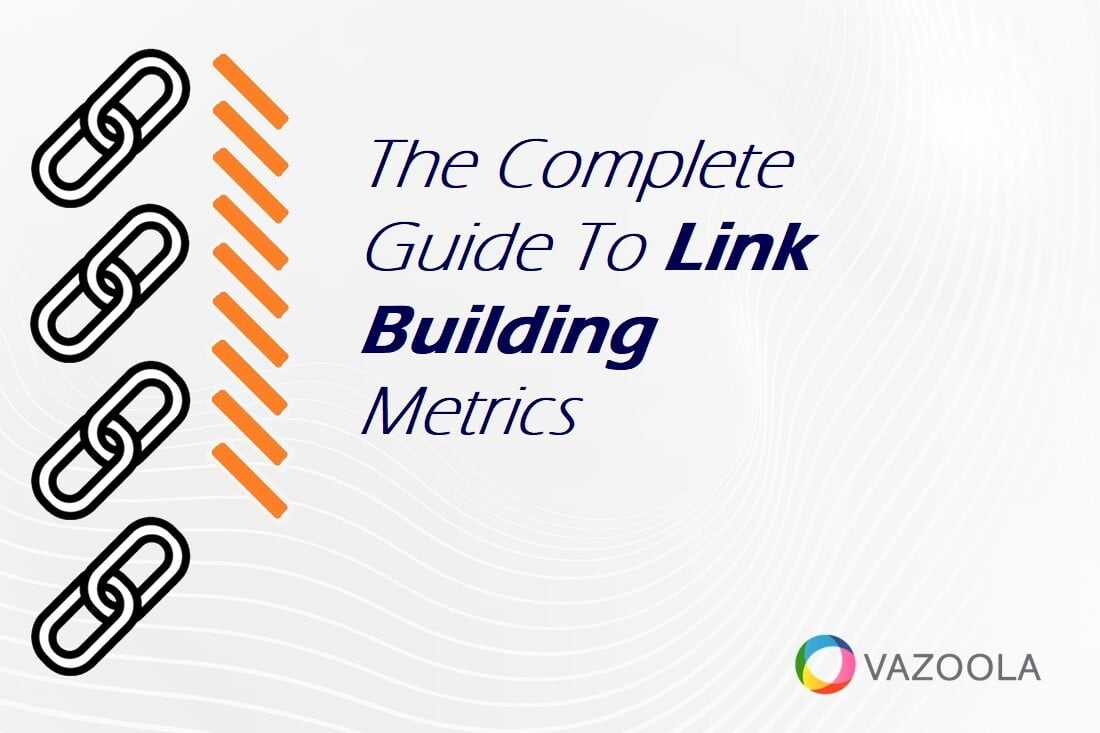
Lost in the link building maze? You can navigate your way to SEO victory with certain essential metrics. Keep reading as we discuss some of the best link building metrics to evaluate the success of your campaign.
After all, link building remains a cornerstone of SEO. Still, deciphering its impact can be a confusing task.
Here at Vazoola, we understand precisely what link data you should follow for a powerful and effective link building campaign. We're here to equip you with the key metrics to track and optimize your strategies.
Whether you're ready to launch a new link building campaign, or you're planning to audit and improve upon existing strategies, the following ink building metrics will help guide you along your way.
Stay with us as we detail the best link building metrics and their significance to link building campaigns. We'll also unlock actionable insights sure to catapult your link building efforts to the top.
Key Takeaways:
-
Understanding and leveraging key link building metrics like Domain Authority and Page Authority can significantly impact your website's search engine rankings and visibility.
-
Advanced link metrics such as Spam Score and Site Age offer deeper insights into the quality of links and credibility of your backlink profile, helping you refine your SEO strategy.
-
Monitoring additional metrics and considerations, including Alexa Rank, anchor text and the balance between a follow vs. a nofollow link, provides a more comprehensive view of your site's SEO health.
-
Utilizing the best tools for monitoring and gaining insights from link metrics is essential for effectively managing your link building efforts and improving your overall SEO performance.
-
Keeping track of these metrics and using specialized tools can guide your link building strategies, ensuring your efforts contribute positively to your site's authority and search engine rankings.
Table of Contents
Best Link Building Metrics
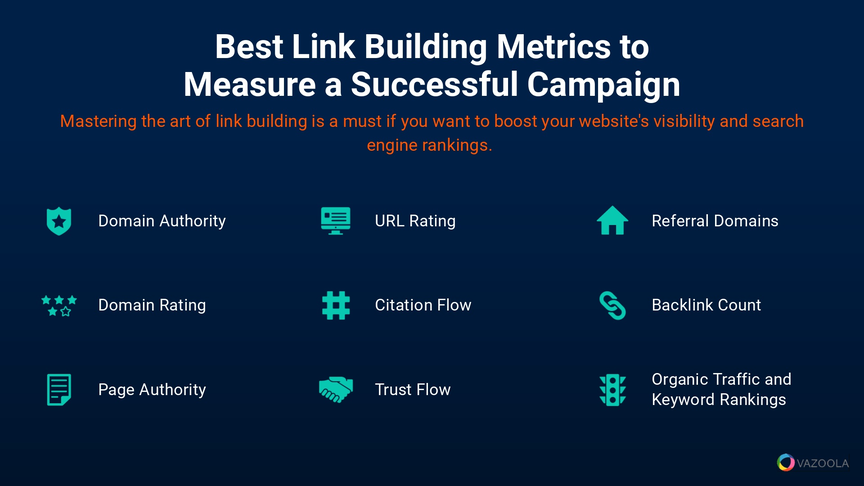
Do you want to boost your website's visibility and search engine rankings? Mastering link building is a must.
At Vazoola, we understand why the precise link metrics considered are important for refining and amplifying your link building campaign. Certain metrics shed light on the efficacy of your strategies and offer insights into areas for improvement.
Of course, a multitude of link metrics can be used to inform link building strategies, but the following offer a good starting point.
Domain Authority (DA) and Domain Rating (DR)
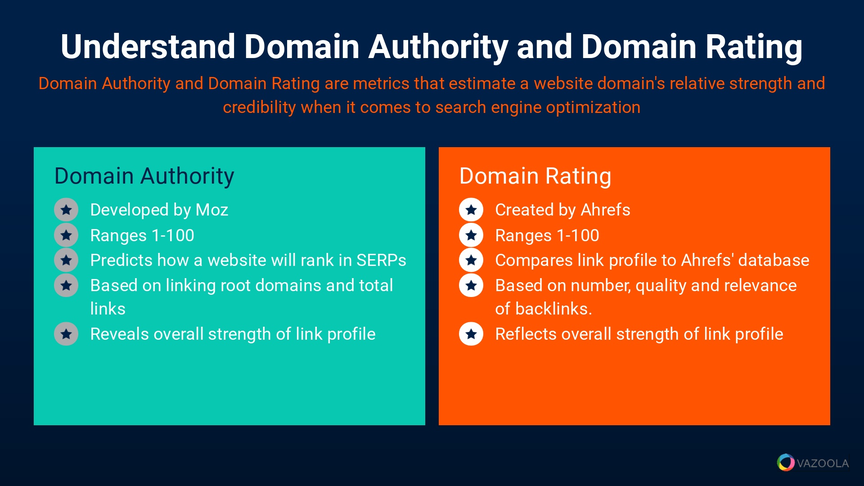
Domain Rating and Domain Authority link metrics estimate linking root domains' relative strength and credibility when it comes to SEO.
Domain Authority
Developed by Moz, Domain Authority ranges from 1 to 100 and predicts how well a website will rank on search engine result pages. DA is based on a variety of factors, including linking root domains and the total number of internal and external links.
In fact, according to an Aira survey, 42% of marketers prefer DA when evaluating all the links pointing to their sites. Try the Moz domain authority checker for free, with Vazoola.
Domain Rating
Domain Rating, on the other hand, is a metric developed by Ahrefs, also ranging from 1 to 100. It reflects the strength of a website's backlink profile compared to the entirety of domains in Ahrefs' database. You can try the Ahrefs domain rating checker for free, with Vazoola here.
An impressive 67% of marketers surveyed by Aira said they look to DR when evaluating links.
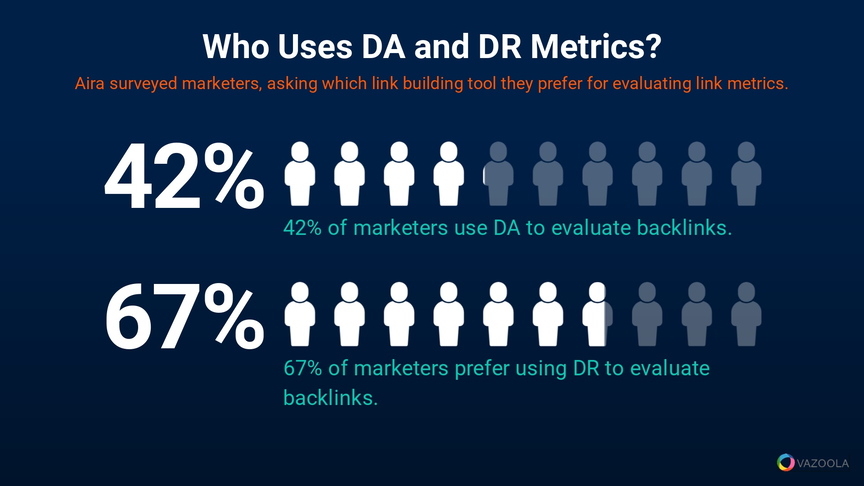
Both of these metrics reflect the overall health and strength of a website's backlink profile. High DA or high DR scores indicate a website is authoritative and trustworthy in its niche. They make it more likely to rank well for relevant queries.
How are DA and DR calculated?
The metrics are determined by analyzing the number, quality and relevance of inbound links pointing to a website.
Several SEO tools offer metrics similar to DA and DR, thereby providing further insights into a website's authority.
SEMrush, for example, offers Authority Score, a compound metric that evaluates the overall quality and SEO performance of a particular domain or webpage. Both free and paid tools let users assess their own website's against high authority websites and potential link-building partners.
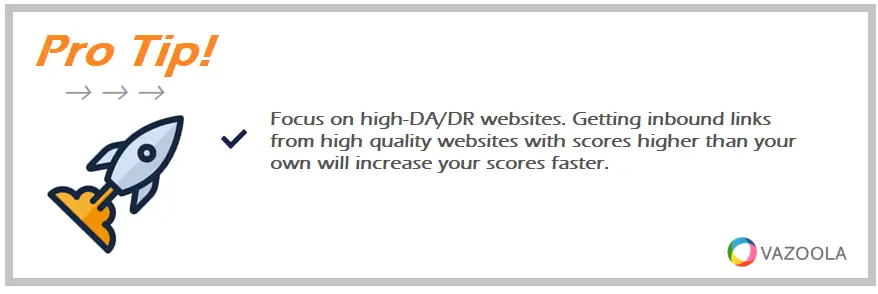
Focus on high-DA/DR websites. Getting inbound links from high quality websites with scores higher than your own will increase your scores faster.
Page Authority (PA) and URL Rating (UR)
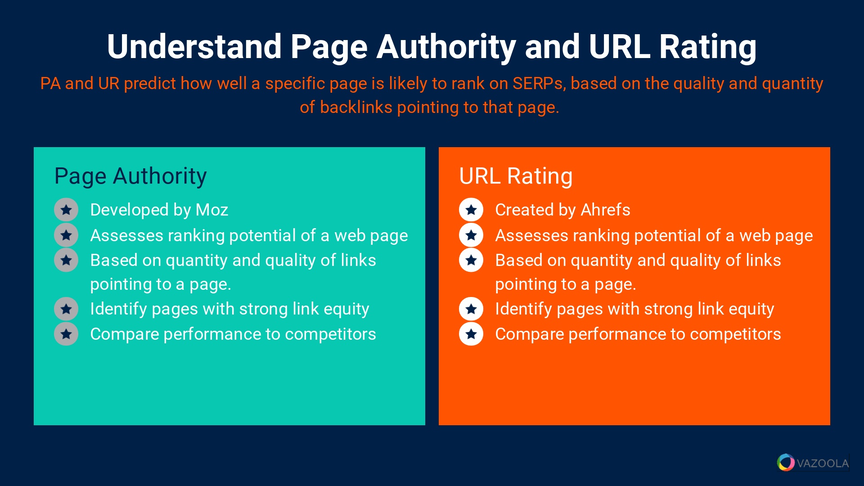
Instead of evaluating entire domains, Page Authority (based on data from the Mozscape web index) and URL Rating (determined by Ahrefs) assess the strength and ranking potential of individual web pages.
PA and UR predict how well a specific page is likely to rank on SERPs. They indicate a page's ranking based on the quality of links and quantity of backlinks pointing to that particular page.
Important metrics, PA and UR help identify pages within a site that have strong link juice. That link juice makes them potential candidates to link internally for further optimization.
To improve your page's PA and UR, we recommend creating high-quality, relevant content that naturally attracts backlinks from trusted, high-authority sites.
Likewise, engage in guest blogging on reputable sites within your niche. Wisely internally link to distribute link equity from high-PA or high-UR pages to other pages that need a boost.
Check your backlinks often, and get rid of low-quality ones. Remember, 94% of link builders told Authority Hacker that link quality is more important than how many inbound links on the site.
Don't be blinded by link building metrics.
— Joe Davies (@fatjoedavies) November 24, 2023
DR90 with 6m traffic, but 5 levels deep in the site hierarchy in a contribution blog ❌
DR35 with 2k traffic on the main blog feed ✅
Meanwhile, we recommend using these metrics to see how well your content is doing compared to others. Study your competitors' pages to learn from their successes.
Look at what kind of content and backlinks work best. Doing so can help you find gaps in your strategy, opportunities to build more links, and other ways to improve your pages' authority and ranking.
Citation Flow (CF) and Trust Flow (TF)
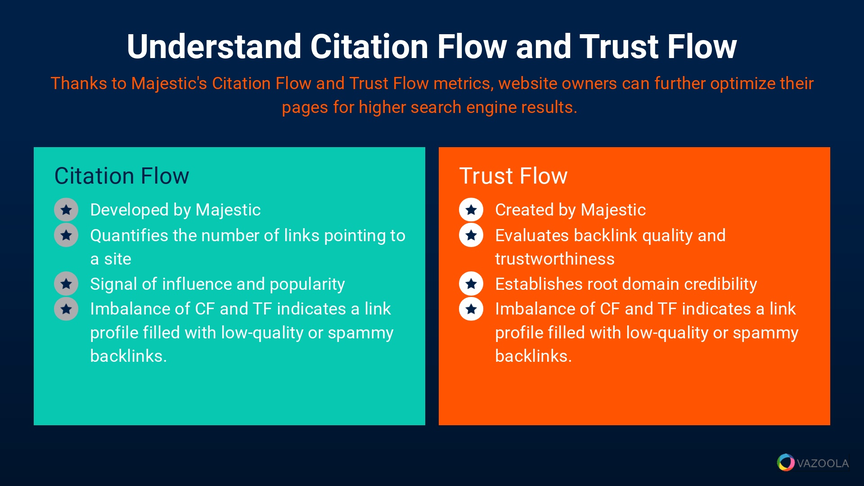
Thanks to Majestic's Citation Flow and Trust Flow metrics, website owners can further optimize their pages for higher search engine results.
CF reflects the number of links pointing to a site, signs of its influence and popularity on the web.
TF, on the other hand, evaluates the quality and trustworthiness of backlinks. A high TF indicates a site's backlinks come from reputable and relevant sources, establishing root domain credibility.
Here at Vazoola, we've learned that balancing CF and TF is a necessary element of a well-rounded backlink profile. A disparity between the two measures, however, can signal issues.
For example, a high CF combined with a low TF could indicate a link profile filled with low-quality or spammy backlinks.
With Majestic's comprehensive dataset, web users can make informed decisions that enhance their site's link profile. Remember, focusing on improving both CF and TF provides for optimal SEO impact.
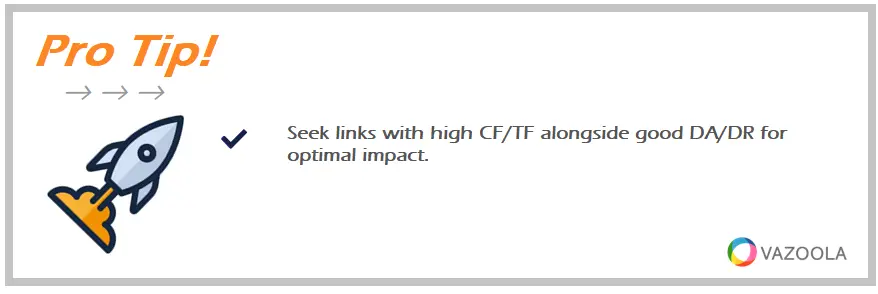
Seek links with high CF/TF alongside good DA/DR for optimal impact.
Referring Domains and Backlink Count
Our experience at Vazoola demonstrates it's more beneficial to boast a few links from a wide range of referral domains than to have a large number of backlinks from a just a few domains.
By focusing on high-quality backlinks, you can boost your site's ranking and drive traffic from your target audience. You also improve your online reputation.
Employ a variety of strategies to increase your referring domains diversity, including guest blogging, participation in relevant online communities, and creating shareable content.
Collaborating with influencers and leveraging social media also can attract backlinks from an array of domains, thereby further enriching your backlink profile.
All links, however, are not the same, and they don't have an equal impact on link building campaigns.
"Nofollow" links tell search engine bots not to pass on link equity, while "dofollow" links directly contribute to your site's search ranking.
Understanding the balance between "nofollow" and "dofollow" links is vital to link building success. "Dofollow" links directly impact your SEO, but "nofollow" links still can drive traffic and increase visibility.
Both link attributes, therefore, play a strategic role in overall link-building efforts.
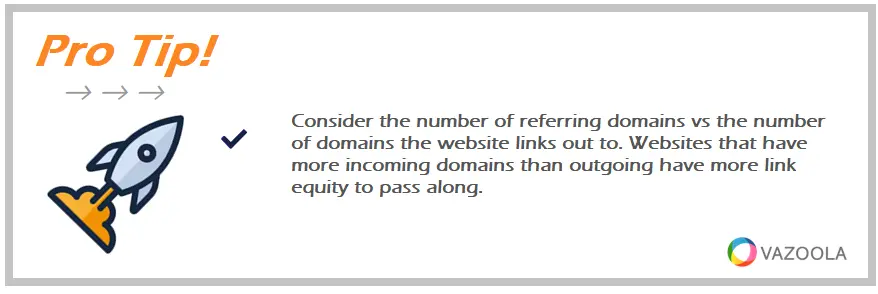
Consider the number of referring domains vs the number of domains the website links out to. Websites that have more incoming domains than outgoing have more link equity to pass along.
Organic Traffic and Keyword Rankings
Effective link building naturally leads to other links and to more organic traffic.
When authoritative sites link to your content, search engines consider your site a valuable resource. Recognition then boosts your visibility in ranking search results, and greater visibility attracts more visitors.
Relevant backlinks also are key to improved keyword rankings.
Links from sites within your niche reinforce your content's relevance to specific keywords and topics.
That sort of relevance boosts your link position in search engine results,. Higher position in search engine results pages or SERPs, of course, makes your site more visible to Google searchers.
Anchor Text
The clickable text in a hyperlink is called anchor text. Here at Vazoola, our experience demonstrates that the anchor text in backlinks is yet another element of SEO success.
Anchor text provides context on the linking page about the content on the linked page. The signals influence how your site ranks for target keywords.
Natural, relevant anchor text, therefore, helps improve your site's relevance for those terms. It's important, however, to vary anchor text to avoid over-optimization, which can lead to penalties.
Advanced SEO Link Metrics
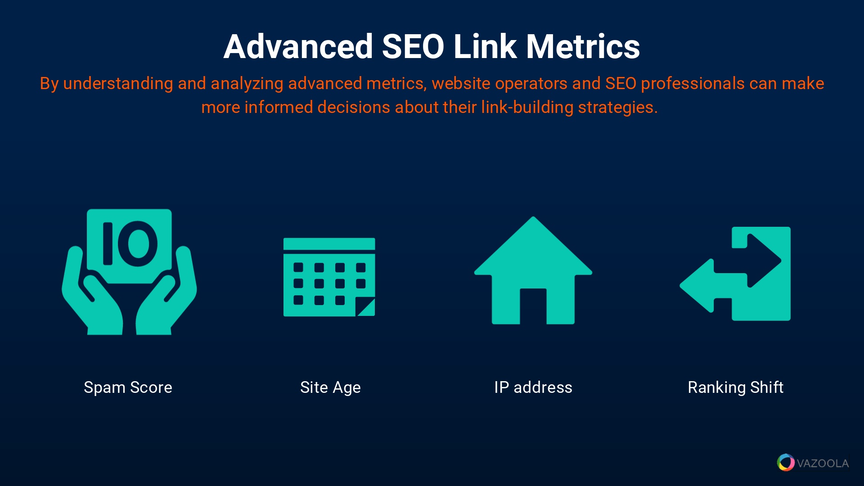
Take a deep dive beyond the above link metrics to discover greater insights into a website's link profile. Metrics like spam score, site age and IP address also play important roles in the quest for higher organic search rankings.
By understanding and analyzing advanced metrics, website operators and SEO professionals can make more informed decisions about their link-building strategies.
We at Vazoola understand these advanced metrics help to unveil potential red flags, gauge longevity and credibility of linking domains, and understand one link profile's diversity.
Spam Score
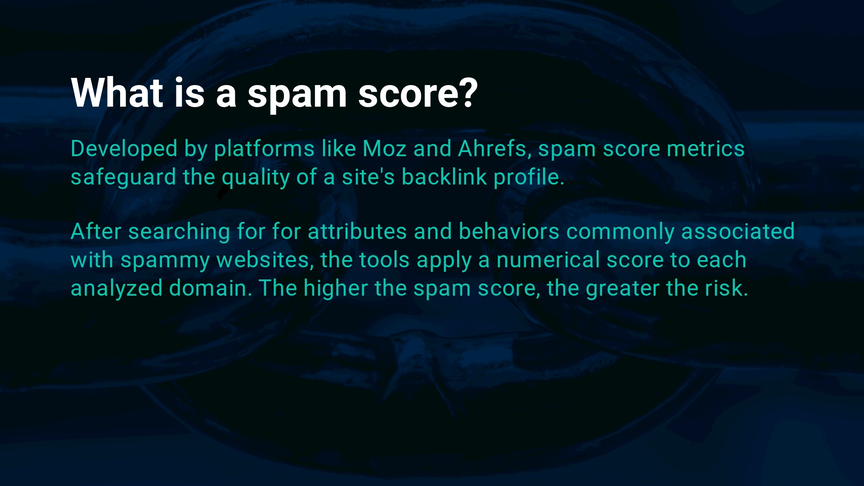
Developed by platforms like Moz and Ahrefs, spam score metrics safeguard the quality of your site's backlink profile.
The innovative tools search for attributes and behaviors commonly associated with spammy websites. They then apply a numerical score to each analyzed domain.
How does the spam scoring system benefit your website? It lets you quickly gauge the potential risk associated with each backlink. The higher the spam score, the greater the risk.
By acknowledging a site's spam score, it's easier to identify links that pose a threat to your site's search engine standing.
In our experience, a high spam score on a linking site suggests the site likely engages in practices like irrelevant link exchanges or questionable content.
Recognizing potentially harmful links early allows for timely intervention. By filtering links from high-spam-score sites, you ensure your link-building campaign yields positive results.
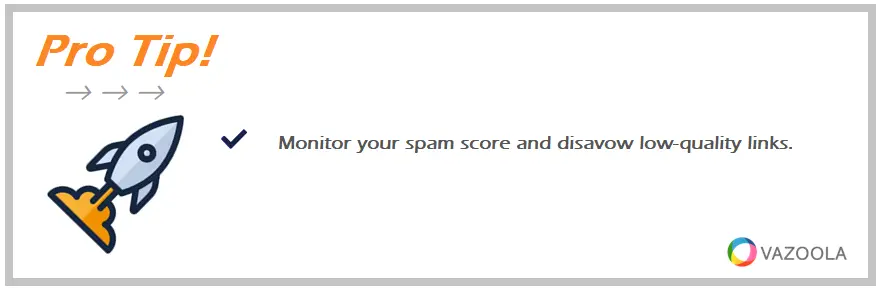
Monitor your spam score and disavow low-quality links.
Site Age
Site age subtly influences SEO efforts since the metric signals both longevity and reliability to search engines. After all, older websites have had plenty of time to establish authority, accumulate content and build plenty of backlinks.
In our experience at Vazoola, a site's historical presence also spells trust, which potentially boosts its visibility with Google and other search engines.
However, site age is just one of many factors considered by search engines. The quality of external links pointing to a site holds far greater importance.
Don't be too concerned if your site is new. High-quality, relevant backlinks from authoritative sources significantly outweigh the benefits of site age.
After all, search engines prioritize content relevance, user experience, and the trustworthiness of backlinks over the age of a website.
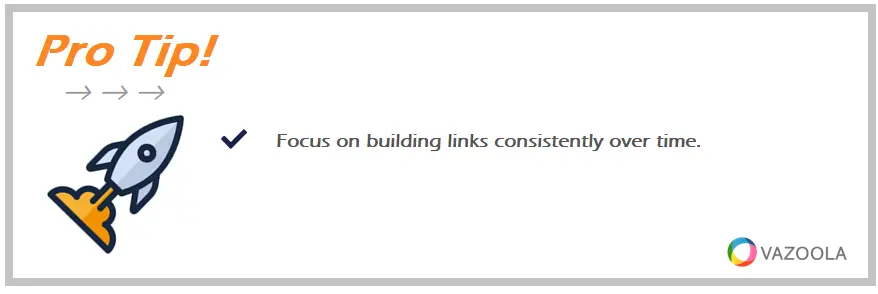
Focus on building links consistently over time.
IP Address
Website operators are well advised to check the IP address of external websites linking to their own. The metric helps identify if multiple backlinks are coming from the same place.
Should too many backlinks originate from the same IP address, it can raise red flags among Google and other search engines.
The scenario often indicates links from private blog networks, which Google deems a manipulative link-building tactic. Thus, too many links from the same place can harm a site's SEO efforts.
Because they aim to offer users valuable and diverse content, Google and other search engines penalize sites associated with PBNs. The penalties range from lost rankings to complete removal from search results, so it's not a risk worth taking.
Ensure you aren't penalized for a redundant IP address by regularly monitoring your backlink profile, and creating the appearance of a natural link-building process.
Tools like Ahrefs and Moz provide insights into backlinks' IP addresses. If you notice a concentration of links from the same IP address, you might need to disavow them with Google's Disavow tools, thereby protecting your site's SEO integrity.
Ranking Shift
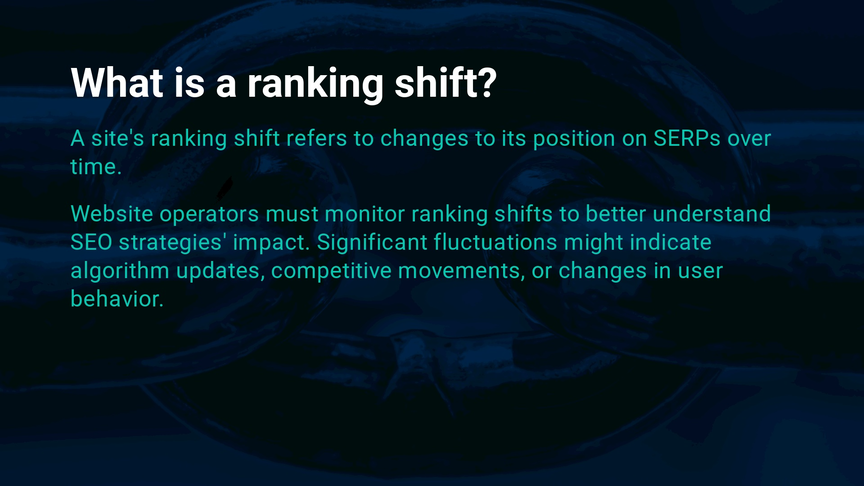
A site's ranking shift refers to changes to its position on SERPs over time.
Website operators must monitor ranking shifts to better understand SEO strategies' impact. Significant fluctuations might indicate algorithm updates, competitive movements, or changes in user behavior.
How do you track ranking shifts? We recommend SEO tools like SEMrush, Ahrefs, or Google Analytics. The platforms provide insights into how individual pages or entire websites move up or down in search rankings for specific keywords.
Analyzing these shifts helps identify which SEO tactics are working and which areas need adjustment.
We also recommend you regularly monitor your site's rankings for target keywords and note any significant changes. Then, investigate the cause of any drastic ranking shifts.
Shifts might be caused by an update to search engine algorithms, increased competition, or changes in content relevance.
Use the insights to refine your SEO strategy, focusing on optimizing content, improving site structure, and enhancing user experience to stabilize and improve your rankings.
Additional Link Metrics and Considerations

At Vazoola, we understand that keeping abreast of a wide range of link building metrics and considerations is necessary to maintain and enhance your website's search engine visibility.
Beyond the primary metrics like Domain Authority and Page Authority, additional factors influence your SEO strategy.
The following considerations offer additional insight into both your website's performance and its competitive standing:
-
Alexa Rank: This Alexa Rank metric scores websites based on traffic data. However, its limitations - including a reliance on data from users who have installed the Alexa toolbar - as well as its declining relevance in the SEO community, make it less reliable as a standalone metric for website performance.
-
Follow vs. Nofollow links: Understanding the difference between "follow" and "nofollow" links is essential for SEO success. A "follow" link passes ranking points and can boost your site's ranking, while "nofollow" links do not. However, both types of links can drive traffic and contribute to your site's visibility.
-
Mobile Usability: With the increasing prevalence of mobile browsing, it's a must to ensure your site is mobile-friendly. Google's mobile-first indexing means your site's mobile version is considered the primary version for ranking purposes.
-
Page Speed: Web page speed is a critical factor for both user experience and SEO. Faster loading times improve user satisfaction and contribute to higher search rankings since Google prioritizes sites that provide a good user experience.
-
Link Graph: A visual representation of the backlinks and interconnections between websites, a link graph illustrates how different pages and sites link to each other. It's used to identify patterns, strengths, and potential weaknesses in a website's backlink profile, helping to uncover strategic link-building opportunities and risks. You can obtain a link graph through various SEO tools and platforms that analyze backlink profiles, such as Ahrefs, Majestic, or Moz.
-
Evolving SEO best practices and metrics: The field of SEO is constantly changing, and search engines regularly update their link metric algorithm. Staying up-to-date on these changes - and evolving your SEO strategies accordingly - is vital to maintain your site's search rankings.
Popular Tools for Monitoring and Evaluating Link Metrics
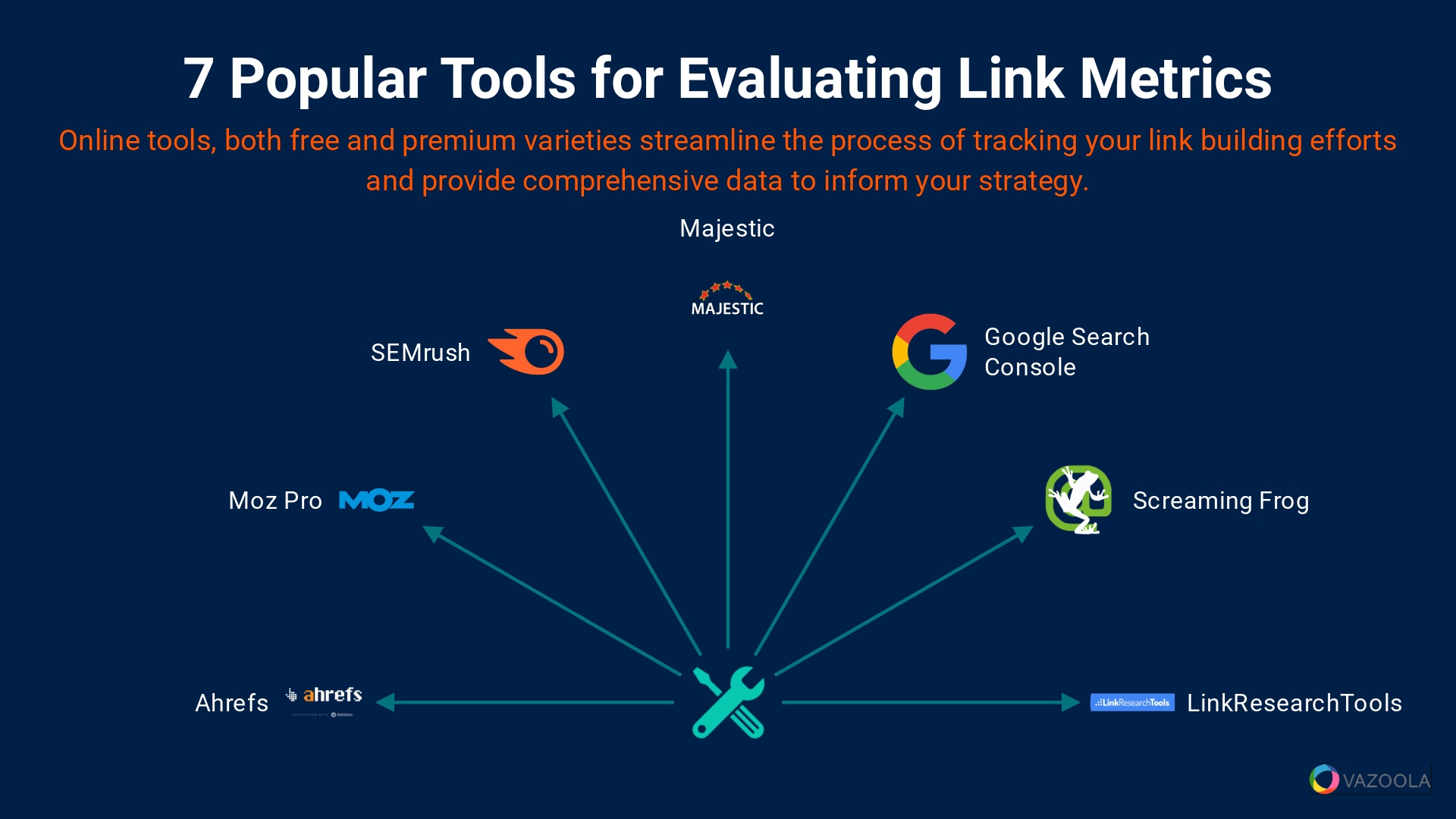
The proper tools are essential for effectively monitoring and gaining insights from link metrics.
We recommend online tools, both free and premium varieties, to streamline the process of tracking your link building efforts and provide comprehensive data to inform your strategy.
Ahrefs is the most popular link building platform, used by 80% of the professionals surveyed by Databox. Other popular tools included Semrush, Moz and Hunter.io.
By leveraging the following tools, you can easily identify high-quality link opportunities, monitor your site's traffic and backlink profile, and stay ahead of potential issues that could impact your SEO performance:
-
Ahrefs: A comprehensive SEO tool, Ahrefs offers detailed insights into backlinks, referring domains, and overall website health. The platform is renowned for its extensive database and the ability to track your site's performance over time.
-
Moz Pro: Known for its Domain Authority metric, Moz Pro provides a suite of SEO tools, including link analysis features. It helps users understand the quality and strength of their and competitors' backlinks.
-
SEMrush: An all-in-one marketing toolkit, SEMrush offers an extensive range of features, including backlink tracking and analysis. The platform is particularly useful for conducting competitive analysis and identifying link-building opportunities.
-
Majestic: Majestic, which specializes in backlink analysis, offers unique metrics like Citation Flow and Trust Flow. It's ideal for those hoping to dive deep into the quality and structure of their link profiles.
-
Google Search Console: Google offers a free tool that provides insights into a site's performance in search results, including how many links it receives. The Google Search Console is absolutely essential for understanding how Google views your site.
-
Screaming Frog SEO Spider: Primarily a website crawler, Screaming Frog can be used to identify and analyze backlinks, especially when integrated with other SEO tools for a more comprehensive view.
-
LinkResearchTools: LRT specializes in link analysis and provides a detailed examination of your backlink profile. The tool is particularly useful for identifying potentially harmful links and conducting risk management.
Boost Your Web Page By Following Your Link Building Campaign Metrics
Understanding and monitoring link metrics are vital for a successful link building campaign. No two sites are the same, so there's no single strategy that works for any website.
Link building metrics like domain authority, the number of linking domains and anchor text help not only identify high-quality link opportunities but also avoid pitfalls that could harm your site's search engine rankings.
What is the best way to judge real authority on a site? 🤔
— Gareth Boyd (@garethaboyd) March 7, 2023
Third-party metrics are easily swayed and are only sometimes correct or lag significantly. 😕
This is great for your site, link building, or competitor tracking.
Google usually hides authority in plain sight. 🙈
Regular analysis through backlink audits allows for the fine-tuning of link building strategies. It also ensures your efforts yield the most visibility, traffic, and overall online presence.
Here at Vazoola, we encourage our readers to stay proactive when tracking and analyzing link building metrics. After all, the SEO landscape is ever-evolving, so staying informed about the latest best practices and metrics will keep you ahead in the game.
Don't miss out on the opportunity to elevate your website's performance. Subscribe to our newsletter, share this blog post with your network, and explore our other resources for more insights and tips on mastering SEO.
Together, let's build a stronger, more visible web presence for your site.

